4.8.2016 | 16:01
Going Berserk in Iceland
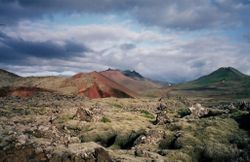 One of the most rugged and beautiful, and most importantly, untouched lava fields in Iceland, is the one called Berserkjahraun. (Berserk-lava). It is located on the northern side of Snæfellsnes peninsula, and just as you come down the mountain highway crossing over the peninsula at Vatnaleið, it it comes into view.
One of the most rugged and beautiful, and most importantly, untouched lava fields in Iceland, is the one called Berserkjahraun. (Berserk-lava). It is located on the northern side of Snæfellsnes peninsula, and just as you come down the mountain highway crossing over the peninsula at Vatnaleið, it it comes into view.I love this area, the colorful and variably shaped mountains around the lava field, but perhaps most of all the stories and legends associated with this part of the land. One of them tells of how the lava field got its name.
Most people have heard of the phrase, going Berserk.
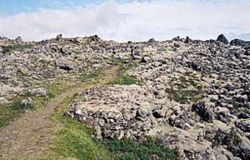 One of the extraordinary features of the lava field is a ancient road (1200 meters long) that cuts into the field. Many believe it to be the oldest man made artifact in Iceland, still in it's original form. And the story of why its was build and why the field came to be named after the Berserks, is recorded in one of Iceland's Saga the Eyrbyggja. It also explains the old burial mound, and the ancient sheep pen still visible in the lava field.
One of the extraordinary features of the lava field is a ancient road (1200 meters long) that cuts into the field. Many believe it to be the oldest man made artifact in Iceland, still in it's original form. And the story of why its was build and why the field came to be named after the Berserks, is recorded in one of Iceland's Saga the Eyrbyggja. It also explains the old burial mound, and the ancient sheep pen still visible in the lava field.Most people have heard of the phrase "Going Berserk". Berserkers (or berserks) were champion Norse warriors who are primarily reported in the Old Norse literature to have fought in a nearly uncontrollable, trance-like fury, a characteristic which later gave rise to the English word berserk. These Viking champions would often go into battle without mail-coats; the word "berserk" meant going into battle wearing only wolf or animal skins.Berserkers are attested to in numerous Old Norse sources.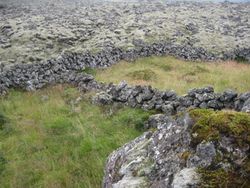

The Saga tells us about two Swedish berserks, Halli and Leiknir, who Vermundur the Slim, farmer at Bjarnarhofn, brought to the country from Norway in 982. Vermundur’s brother, Styr the Slayer, was a powerful wretch, who Vermundur wanted to stand up to, and figured he would be able to do so with the aid of the Berserks The problem, however, was that Vermundur could not keep the berserks busy enough to subdue their rage and saw no other solution than to ask his brother to take them off his hands. Styr the Slayer obliged reluctantly and soon found himself in a dilemma in spite of continuous killings. Then Halli, one of the berserks, fell in love with his daughter and asked for her hand in marriage.
Styr the Slayer went to his friend, Snorri the chieftain, at Helgafell to seek advice. When he came back, he told the berserks that he would give Halli his blessing after they had finished clearing a path through the rugged lava field, build a boundary fence across it, and a sheep pen in it. The Berserks went berserk and finished the tasks in a remarkably short time. Before they did however, Styr the Slayer prepared an underground sauna for them and covered it with thick boards of wood. When the Berserks returned tired and sweaty from their work, Styr invited them to relax in the sauna and they accepted. The hole was covered properly, big boulders put on the boards and excessive quantities of boiling hot water poured through the opening styr had prepared, on to the hot stones below. It soon became unbearably hot in the hole, but in spite of the heat, the berserks managed to break out. They were however much too weak to defend themselves against Styr the slayer. He had spread wet and slippery bull hides on the ground around the hole and succeeded in killing both the Berserks. Their bodies were taken into a depression in the lava field, where they were buried close to the bridle path as can be seen up to this date.
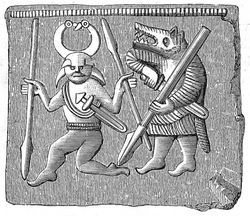 The Berserks are probably also responsible for the legends of werewolves we have all become so fascinated with of late. The Úlfhéðnar (singular Úlfheðinn and means Wolf warrior), is another term associated with berserkers and mentioned in the Vatnsdæla saga, were Berserks said to have worn the pelt of a wolf when they entered battle.
The Berserks are probably also responsible for the legends of werewolves we have all become so fascinated with of late. The Úlfhéðnar (singular Úlfheðinn and means Wolf warrior), is another term associated with berserkers and mentioned in the Vatnsdæla saga, were Berserks said to have worn the pelt of a wolf when they entered battle.Úlfhéðnar are also sometimes described as Odin's special warriors: that is men who went without their mail coats and were mad as hounds or wolves, bit their shields as they slew men, and neither fire nor iron had any effect upon them. This was called "going berserk".
Yet another connection the Berserk have with Iceland is the infamous Berserk mushroom. The Berserk were by many suspected of obtaining their trance like state, by consuming some kind of a psychedelic drug. The obvious candidate is the berserk mushroom or Amanita muscaria that grows in several places in Iceland
Flokkur: Stjórnmál og samfélag | Breytt s.d. kl. 16:14 | Facebook
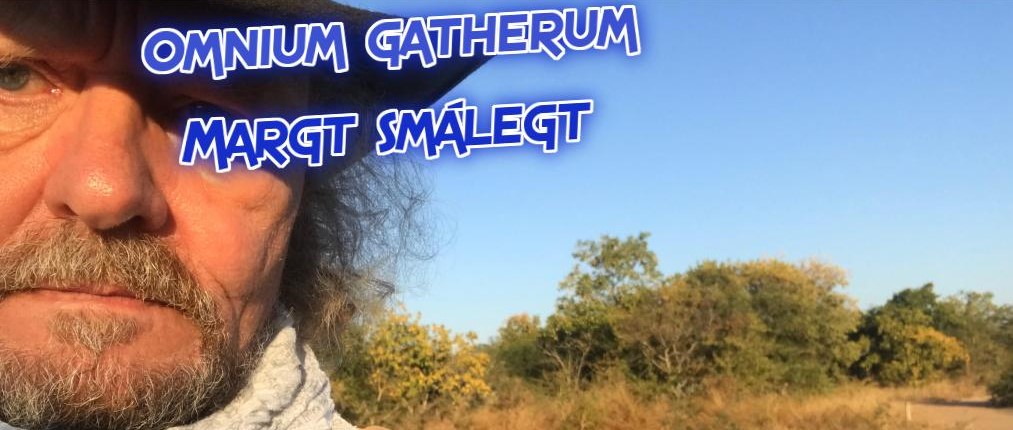

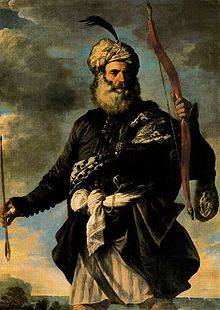


 Dagný
Dagný
 Sigrún Jónsdóttir
Sigrún Jónsdóttir
 Anna Einarsdóttir
Anna Einarsdóttir
 Anna Gísladóttir
Anna Gísladóttir
 Arnar Pálsson
Arnar Pálsson
 Arinbjörn Kúld
Arinbjörn Kúld
 Ketill Sigurjónsson
Ketill Sigurjónsson
 Sóldís Fjóla Karlsdóttir
Sóldís Fjóla Karlsdóttir
 Egill Bjarnason
Egill Bjarnason
 Baldur Kristjánsson
Baldur Kristjánsson
 Bergljót Gunnarsdóttir
Bergljót Gunnarsdóttir
 Bjarni Harðarson
Bjarni Harðarson
 Sigurbjörn Friðriksson
Sigurbjörn Friðriksson
 Anna
Anna
 Gunnhildur Sigurjónsdóttir
Gunnhildur Sigurjónsdóttir
 Guðmundur Ásgeirsson
Guðmundur Ásgeirsson
 brahim
brahim
 Charles Robert Onken
Charles Robert Onken
 Hannes
Hannes
 Tryggvi Hjaltason
Tryggvi Hjaltason
 Anna S. Árnadóttir
Anna S. Árnadóttir
 Hrannar Baldursson
Hrannar Baldursson
 Dúa
Dúa
 Drífa Kristjánsdóttir
Drífa Kristjánsdóttir
 Edda Agnarsdóttir
Edda Agnarsdóttir
 Viðar Eggertsson
Viðar Eggertsson
 Einar G. Harðarson
Einar G. Harðarson
 Erla J. Steingrímsdóttir
Erla J. Steingrímsdóttir
 Evrópusamtökin, www.evropa.is
Evrópusamtökin, www.evropa.is
 Eydís Hentze Pétursdóttir
Eydís Hentze Pétursdóttir
 Friðrik Hansen Guðmundsson
Friðrik Hansen Guðmundsson
 Finnur Bárðarson
Finnur Bárðarson
 Fjarki
Fjarki
 Púkinn
Púkinn
 Brosveitan - Pétur Reynisson
Brosveitan - Pétur Reynisson
 Brattur
Brattur
 Hjálmtýr V Heiðdal
Hjálmtýr V Heiðdal
 Guðmundur Pálsson
Guðmundur Pálsson
 Graceperla
Graceperla
 Grétar Mar Jónsson
Grétar Mar Jónsson
 Greta Björg Úlfsdóttir
Greta Björg Úlfsdóttir
 Guðjón Ó.
Guðjón Ó.
 Guðmundur Júlíusson
Guðmundur Júlíusson
 Gulli litli
Gulli litli
 Gylfi Guðmundsson
Gylfi Guðmundsson
 Halla Rut
Halla Rut
 Hallmundur Kristinsson
Hallmundur Kristinsson
 Haraldur Rafn Ingvason
Haraldur Rafn Ingvason
 Þorkell Sigurjónsson
Þorkell Sigurjónsson
 Helgi Jóhann Hauksson
Helgi Jóhann Hauksson
 Aðalheiður Haraldsdóttir
Aðalheiður Haraldsdóttir
 Kaleb Joshua
Kaleb Joshua
 Hildur Helga Sigurðardóttir
Hildur Helga Sigurðardóttir
 Himmalingur
Himmalingur
 Hjalti Rúnar Ómarsson
Hjalti Rúnar Ómarsson
 Sigga Hjólína
Sigga Hjólína
 Bókaútgáfan Hólar
Bókaútgáfan Hólar
 Höskuldur Búi Jónsson
Höskuldur Búi Jónsson
 Hrafn Andrés Harðarson
Hrafn Andrés Harðarson
 Hugrún Jónsdóttir
Hugrún Jónsdóttir
 Óskar Arnórsson
Óskar Arnórsson
 Þráinn Jökull Elísson
Þráinn Jökull Elísson
 Svava frá Strandbergi
Svava frá Strandbergi
 Kári Gautason
Kári Gautason
 Jón Baldur Lorange
Jón Baldur Lorange
 Jenný Stefanía Jensdóttir
Jenný Stefanía Jensdóttir
 Jens Guð
Jens Guð
 Jóhann G. Frímann
Jóhann G. Frímann
 Jóhannes Þór Skúlason
Jóhannes Þór Skúlason
 Jóna Á. Gísladóttir
Jóna Á. Gísladóttir
 Jonni
Jonni
 Bergur Thorberg
Bergur Thorberg
 Kalikles
Kalikles
 ÞJÓÐARSÁLIN
ÞJÓÐARSÁLIN
 Hjalti Tómasson
Hjalti Tómasson
 kiza
kiza
 Hrafnhildur Ýr Vilbertsdóttir
Hrafnhildur Ýr Vilbertsdóttir
 Hrafnhildur Þórarinsdóttir
Hrafnhildur Þórarinsdóttir
 Kristberg Snjólfsson
Kristberg Snjólfsson
 Kolbrún Hilmars
Kolbrún Hilmars
 Kristinn Theódórsson
Kristinn Theódórsson
 OM
OM
 Lilja Guðrún Þorvaldsdóttir
Lilja Guðrún Þorvaldsdóttir
 SeeingRed
SeeingRed
 Lýður Pálsson
Lýður Pálsson
 Lýður Árnason
Lýður Árnason
 Margrét St Hafsteinsdóttir
Margrét St Hafsteinsdóttir
 Máni Ragnar Svansson
Máni Ragnar Svansson
 Marinó G. Njálsson
Marinó G. Njálsson
 Marinó Már Marinósson
Marinó Már Marinósson
 Magnús Bergsson
Magnús Bergsson
 Mofi
Mofi
 Sigmar Þór Sveinbjörnsson
Sigmar Þór Sveinbjörnsson
 Jóhanna Magnúsdóttir
Jóhanna Magnúsdóttir
 Nexa
Nexa
 Sigurður Þór Guðjónsson
Sigurður Þór Guðjónsson
 Aðalsteinn Baldursson
Aðalsteinn Baldursson
 Jón Svavarsson
Jón Svavarsson
 Páll Vilhjálmsson
Páll Vilhjálmsson
 Sandra María Sigurðardóttir
Sandra María Sigurðardóttir
 Sveinbjörn Kristinn Þorkelsson
Sveinbjörn Kristinn Þorkelsson
 Vilhjálmur Örn Vilhjálmsson
Vilhjálmur Örn Vilhjálmsson
 Ragnar Þór Ingólfsson
Ragnar Þór Ingólfsson
 Heimir Tómasson
Heimir Tómasson
 Sæmundur Bjarnason
Sæmundur Bjarnason
 Salvör Kristjana Gissurardóttir
Salvör Kristjana Gissurardóttir
 Sammý
Sammý
 Sigurður Fannar Guðmundsson
Sigurður Fannar Guðmundsson
 Sigurður Þórðarson
Sigurður Þórðarson
 Sigurður Ingólfsson
Sigurður Ingólfsson
 Sigþrúður Pálsdóttir
Sigþrúður Pálsdóttir
 Sigurveig Eysteins
Sigurveig Eysteins
 Sigurður Jónsson
Sigurður Jónsson
 Axel Jóhann Hallgrímsson
Axel Jóhann Hallgrímsson
 Auðun Gíslason
Auðun Gíslason
 Óskar Þorkelsson
Óskar Þorkelsson
 Helga skjol
Helga skjol
 Gunnar Skúli Ármannsson
Gunnar Skúli Ármannsson
 hilmar jónsson
hilmar jónsson
 Steinunn Helga Sigurðardóttir
Steinunn Helga Sigurðardóttir
 Þorsteinn Briem
Þorsteinn Briem
 Kristín M. Jóhannsdóttir
Kristín M. Jóhannsdóttir
 Grétar Eiríksson
Grétar Eiríksson
 Sigurður Árnason
Sigurður Árnason
 Svala Jónsdóttir
Svala Jónsdóttir
 Svartagall
Svartagall
 Óskar Helgi Helgason
Óskar Helgi Helgason
 TARA
TARA
 Þarfagreinir
Þarfagreinir
 Þór Saari
Þór Saari
 Þorsteinn Helgi Steinarsson
Þorsteinn Helgi Steinarsson
 Þórdís Bachmann
Þórdís Bachmann
 Þór Ludwig Stiefel TORA
Þór Ludwig Stiefel TORA
 Sigurður Rósant
Sigurður Rósant
 Valdimar H Jóhannesson
Valdimar H Jóhannesson
 Andrea
Andrea
 Villi Asgeirsson
Villi Asgeirsson
 Margrét Sigurðardóttir
Margrét Sigurðardóttir
 Guðsteinn Haukur Barkarson
Guðsteinn Haukur Barkarson
 Steinþór Ásgeirsson
Steinþór Ásgeirsson
 Sveinn Atli Gunnarsson
Sveinn Atli Gunnarsson
Bæta við athugasemd [Innskráning]
Ekki er lengur hægt að skrifa athugasemdir við færsluna, þar sem tímamörk á athugasemdir eru liðin.